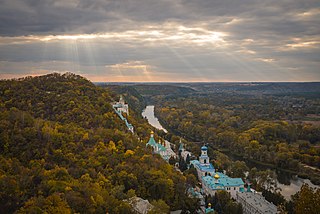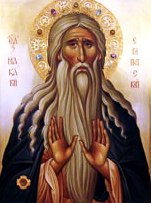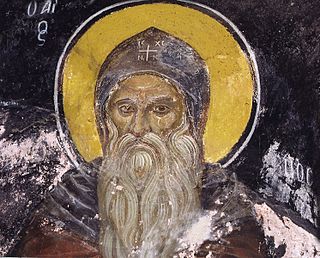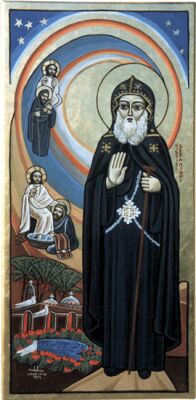Related Research Articles

Anthony the Great was a Christian monk from Egypt, revered since his death as a saint. He is distinguished from other saints named Anthony, such as Anthony of Padua, by various epithets: Anthony of Egypt, Anthony the Abbot, Anthony of the Desert, Anthony the Anchorite, Anthony the Hermit, and Anthony of Thebes. For his importance among the Desert Fathers and to all later Christian monasticism, he is also known as the Father of All Monks. His feast day is celebrated on 17 January among the Eastern Orthodox and Catholic churches and on Tobi 22 in the Coptic calendar.

Moses the Black, also known as Moses the Strong, Moses the Abyssinian, Moses the Robber, and Moses the Ethiopian, was an ascetic monk and priest in Egypt in the fourth century AD, and a Desert Father. He is highly venerated in the Eastern Orthodox Church and the Oriental Orthodox Church. According to stories about him, he converted from a life of crime to one of asceticism. He is mentioned in Sozomen's Ecclesiastical History, written about 70 years after Moses's death.

A lavra or laura is a type of monastery consisting of a cluster of cells or caves for hermits, with a church and sometimes a refectory at the center. Lavra monasteries operate within the Orthodox and other Eastern Christian traditions; the name is also used by some Catholic communities. The term in Greek initially meant a narrow lane or an alley in a city.

Macarius of Egypt was a Christian monk and hermit. He is also known as Macarius the Elder or Macarius the Great.

Saint Macarius of Alexandria was a monk in the Nitrian Desert. He was a slightly younger contemporary of Macarius of Egypt, and is thus also known as Macarius the Younger.

The Desert Fathers or Desert Monks were early Christian hermits and ascetics, who lived primarily in the Scetes desert of the Roman province of Egypt, beginning around the third century AD. The Apophthegmata Patrum is a collection of the wisdom of some of the early desert monks and nuns, in print as Sayings of the Desert Fathers. The first Desert Father was Paul of Thebes, and the most well known was Anthony the Great, who moved to the desert in AD 270–271 and became known as both the father and founder of desert monasticism. By the time Anthony had died in AD 356, thousands of monks and nuns had been drawn to living in the desert following Anthony's example, leading his biographer, Athanasius of Alexandria, to write that "the desert had become a city." The Desert Fathers had a major influence on the development of Christianity.

Ammon, Amun, Ammonas, Amoun (Ἀμοῦν), or Ammonius the Hermit was a 4th-century Christian ascetic and the founder of one of the most celebrated monastic communities in Egypt. He was subsequently declared a saint. He was one of the most venerated ascetics of the Nitrian Desert, and Athanasius of Alexandria mentions him in his life of Anthony the Great.

Melania the Elder, Latin Melania Maior was a Desert Mother who was an influential figure in the Christian ascetic movement that sprang up in the generation after the Emperor Constantine made Christianity a legal religion of the Roman Empire. She was a contemporary of, and well known to, Abba Macarius and other Desert Fathers in Egypt, Jerome, Augustine of Hippo, Paulinus of Nola, and Evagrius of Pontus, and she founded two religious communities on the Mount of Olives in Jerusalem. She stands out for the convent she founded for herself and the monastery she established in honour of Rufinus of Aquileia, which belongs to the earliest Christian communities, and because she promoted the asceticism which she, as a follower of Origen, considered indispensable for salvation.

Kellia, referred to as "the innermost desert", was a 4th-century Egyptian Christian monastic community spread out over many square kilometers in the Nitrian Desert about 40 miles south of Alexandria. It was one of three centers of monastic activity in the region, along with Nitria and Scetis. It is called al-Muna in Arabic and was inhabited until the 9th century. Only archaeological sites remain there today.

Wadi El Natrun is a depression in northern Egypt that is located 23 m (75 ft) below sea level and 38 m (125 ft) below the Nile River level. The valley contains several alkaline lakes, natron-rich salt deposits, salt marshes and freshwater marshes.
The Nitrian Desert is a desert region in northwestern Egypt, lying between Alexandria and Cairo west of the Nile Delta. It is known for its history of Christian monasticism.

Pambo was a Coptic Desert Father of the fourth century and disciple of Anthony the Great. His feast day is July 18 among the Oriental Orthodox, Eastern Orthodox, and Catholic churches.

The Lausiac History is a seminal work archiving the Desert Fathers written in 419-420 AD by Palladius of Galatia, at the request of Lausus, chamberlain at the court of the Byzantine Emperor Theodosius II.
Palladius of Galatia or Palladius of Helenopolis was a Christian chronicler and the bishop of Helenopolis in Bithynia. He was a devoted disciple of Saint John Chrysostom. He is best remembered for his work, the Lausiac History. He was also the author of the Dialogue on the Life of Chrysostom. Palladius is a saint in the Coptic Orthodox Church and in the Syrian Orthodox Church, wherein he is given the honorific title, The Solitary. His feast day is November 29.

The Sayings of the Desert Fathers is the name given to various textual collections consisting of stories and sayings attributed to the Desert Fathers and Desert Mothers from approximately the 5th century AD.

Bishoy of Scetis, known in the Coptic Orthodox Church of Alexandria as the Star of the Desert and the Beloved of our Good Savior, was a Coptic Desert Father. He is said to have seen Jesus, and been bodily preserved to the present day via incorruptibility at the Monastery of Saint Bishoy in the Nitrian Desert, Egypt. He is venerated by the Oriental Orthodox Churches and the Eastern Orthodox Church, and is known in the latter under the Greek version of his name, Paisios.
Nitria is one of the earliest Christian monastic sites in Egypt and is located in the Nitrian Desert. It was the first of the three major centers of Christian monastic activity in the Lower Egypt, the other two being Kellia and Scetis.
Cronius of Nitria was an Egyptian Christian monk who lived in Nitria, Lower Egypt. He was one of the Desert Fathers.
Isaac of the Cells was an Egyptian Christian monk who lived during the 4th and 5th centuries in Nitria, Lower Egypt. He was one of the Desert Fathers.
Or of Nitria was an Egyptian Orthodox Christian ascetic who lived around the 4th century AD in Egypt in Dalga, Nitria, the Thebaid, and in the deserts around Shaina. He is one of the lesser-known Desert Fathers, but is nevertheless regarded as one of the "chief among monks", being "a man who stood out among many of the fathers". He is associated with Theodore and Sisoes the Great. According to Jerome, at one point during his life, Or was the father of "one thousand [cenobitic] monks" in the Egyptian Desert. Or died c. 390.
References
- 1 2 Ward, Benedicta (1984). The sayings of the Desert Fathers: the alphabetical collection. Kalamazoo, MI: Cistercian Publications. ISBN 0-87907-959-2.
- ↑ "Venerable Cherimon (Chaeremon) of Egypt". Orthodox Church in America. 2020-08-16. Retrieved 2021-11-15.